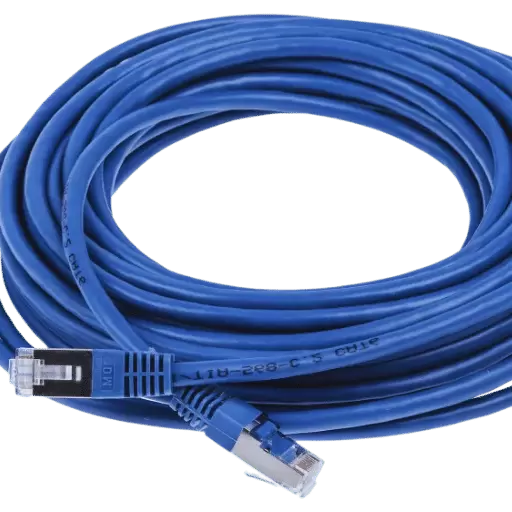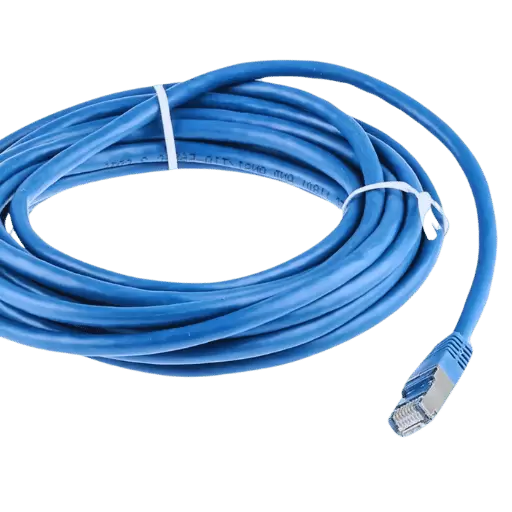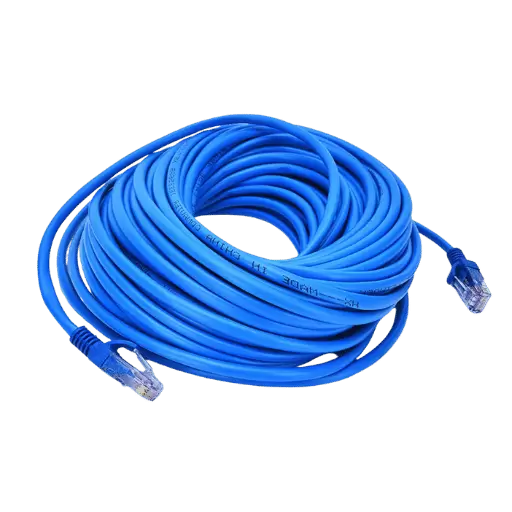The demand for fast, reliable, and efficient data transmission systems has never been higher in the rapidly changing world of networking technology. Among the many ethernet cables available today, cat 6 cables are highly rated and have the best performance and adaptability. This all-inclusive guide is meant to familiarize readers with the basics of Cat 6 Ethernet cables by providing an overview of its design features, capabilities, and fields of application. Whether you are setting up a sophisticated home network configuring a high-performance office, or simply want to learn more about advanced Ethernet cabling techniques, this will be your ultimate source of information. In addition, we shall consider how it is installed as well as technical specifications that need to be met so as to create modern networking designs that make use of it because these are some impressive reasons why cat6 cable should be adopted over other kinds of wire networks.

The twisted pair cable is also known as a Cat 6 Ethernet Cable. It was standardized for Ethernet and other network physical layers to deliver fast data transfer rates. It supports frequencies of up to 250 MHz and can transmit data over short distances of up to 55 meters at speeds up to 10 Gbps. This is achieved through the superior construction of the cable, which has tighter twisting in each pair and improved shielding techniques that combat crosstalk alongside electromagnetic interference as well. Cat 6 cables are compatible with Cat 5 and Cat 5e standards; hence, they are useful in all kinds of applications ranging from simple home networks to complex enterprise environments. By using Cat 6 cables, organizations will have reliable connections between devices due to enhanced system performance and efficient data flow necessary for high-performance networking requirements that continue in the future.
Cat 6 cables possess several technological benefits over the past ones making them a preferred choice in either residential or commercial networking.
In conclusion, enhanced technical aspects such as higher data transmission speeds, increased bandwidth levels, reduced crosstalk / interference issues, backwards compatibility and better support for PoE makes it reasonable to use Cat6s even in demanding networking environments.
Comparing Cat 6 cables to Cat 5 and Cat 5e reveals numerous technical differences. Among the first and most commonly used networks is Cat 5 cables that support speeds up to 100 Mbps and bandwidths of 100 MHz. Conversely, being an improved version does not alter the fact that Cat 5e still operates at a frequency of exactly one hundred megahertz but has enhanced performance because it reduces crosstalk between wires, supporting speeds more than ten times faster over short distances.
On the other hand, however, Cat Six outdoes them by supporting speeds as high as ten gigabits per second with bandwidths going beyond two hundred fifty megahertz, improving data transmission rate, especially for high-speed and high-volume transferring environments. On top of that, its advanced shields and tighter twisted pairs are key in minimizing cross-talk as well as electromagnetic interference (EMI), which consequently results in more reliable connections with fewer fluctuations.
Basically, while Cat 5 or even Cat 5e may be sufficient for less intense applications such as domestic use at home or small scale businesses; rather they can simply fail to meet modern networking needs due to their reduced performance level for data transfer rates i.e., low speed and small bandwidth plus susceptibility.

When one is choosing a Cat 6 ethernet cable, there are several important factors that they should bear in mind:
When making a choice between shielded (STP or FTP) and unshielded (UTP) Cat 6 Ethernet cables, it is necessary to be aware of their respective benefits as well as the technical parameters that warrant their use in different settings.
Shielded Cat 6 Cables (STP/FTP):
Technical Parameters:
Unshielded Cat 6 Cables (UTP):
Technical Parameters:
In conclusion, one should choose between shielded and unshielded Cat 6 Ethernet cables basing on specific environmental conditions and the amount of electromagnetic interference. For high-interference settings, shielded cables offer superior protection and stability while unshielded cables provide a cost-effective and flexible solution to less demanding environments.
A Snagless Cat 6 Ethernet Cable has a distinctive molded boot over the connector, which prevents accidental snapping of the release tab when it is being installed or removed to avoid catching it on other cables and objects. It keeps the connector intact, which, in turn, aids in establishing a definite connection. Snagless design makes the cable durable, thus it is ideal for environments where cables are frequently tampered with or moved such as data centers and office networks. Moreover, this enables easy cable management while minimizing downtime during maintenance activities.

For instance, Cat 6 Ethernet cables are designed to meet specific technical parameters that ensure high-speed data transmission and reliable connectivity. Listed below are the primary technical specifications of Cat 6 cables:
In conclusion, these specifications collectively guarantee secure, fast and reliable connections across various network environments through the implementation/the application/use of Category/Cat six/Cat six (Cat6) Ethernet cables.
For Cat 6 Ethernet cables, bandwidth and speed are critical factors that determine their performance.
With these parameters met by Cat 6 cables, they become most suitable for high-speed network applications because they have larger capabilities and better effectiveness thereby making them dependable and with quick transmission of information across varying networking environments.
Fundamental to the high performance of Cat 6 cables is the design of twisted pairs. Each Cat 6 cable consists of four twisted pairings of copper conductors. The twist in these pairs is a vital method used for minimizing crosstalk, which is defined as interference from adjacent wires, and also electromagnetic interference from external sources. As compared with previous standards like Cat 5e, these twists are more tightly controlled in Cat 6 cables. This increased twist rate results in less signal degradation over long distances, thereby permitting stable and consistent data transfer. Moreover, some Cat 6 cables have individual pairs divided by a spline that further preserves pair integrity while reducing internal crosstalk. Hence, this kind of wiring not only improves the cable’s ability to handle high frequencies but also supports better data transfer rates and bandwidths that render Cat 6 cables ideal for present-day high-speed networking environments.

In order to ensure good performance and long service life, the proper installation of Cat 6 Ethernet cables is a fundamental step. The first thing is to watch the cable from being bent too much or twisted or stretched as such actions can harm its inner structure and the quality of the signal. The minimum bend radius should be four times the diameter of the cable. Additionally, use suitable systems for managing the cords, like clips, conduits, and cable trays, which will keep them separated and not tangled for future maintenance services. Moreover, maintain a safe distance from any electromagnetic interferences (EMIs) that could come from sources such as power lines and fluorescence lighting fixtures. Lastly, confirm correctly performed terminations and connections using high-standard connectors and modular plugs before testing with a certified cable tester to ascertain their performance specifications. By adhering to these principles, one can achieve an efficient, functional network that is reliable enough in terms of speed and connectivity.
When installing Cat 6 Ethernet cords, several common mistakes can compromise performance and reliability. The most frequent mistake is going past the suggested bend radius, which should not be less than four times the diameter of the cable. Going beyond this limit could harm the internal structure of the cable. Another one is poor cable length management; for a Cat 6cable run, it must not exceed 100 meters (328 feet) to ensure an optimum data transmission rate. In addition, cables should not be mixed with different specifications or quality levels in a single network because of inconsistencies and downgraded signal integrity that may occur as a result. Improper termination is also included—connectors should be crimped properly, and pairs should not be untwisted by more than 0.5 inches. Moreover, failing to protect cables from EMI sources such as power lines or fluorescent lights can cause significant degradation of signals. Lastly, if one forgets to test installed cables using a certified cable tester, they might have undetected problems that could affect network performance. Being aware of these potential pitfalls and following technical parameters will make sure you have a robust and efficient Cat 6 network installation.
To guarantee durability and long life of Cat6 Ethernet cables, it is very essential to have proper maintenance. First of all, detect any obvious damage or wear on the cables and connectors through regular visual inspections. Make sure that all cables are labeled correctly and stored in an orderly manner for easier troubleshooting.
Secondly, using specific cleaning tools periodically clean off dust, dirt or other impurities from the connectors that may interfere with signal quality. Put cover plates on wall outlets while patch panels and racks must remain organized so as to minimize touching physical stress points on the cables.
Thirdly, network management software should be employed to monitor network performance metrics such as latency, throughput error rates among others. It helps in early detection of potential issues ahead of their severe implications to the network. Further, a certified cable tester may be utilized for routine testing planned into a schedule to check out the integrity as well as performance after installation.
Lastly, update and document all changes made on the network infrastructure. Such detailed records can include cable installations or modifications hence making it easy for future maintenance to be done easily and quickly when needed. In order for you to achieve this keep your Cat6 network infrastructure at its optimum performance levels thereby extending its useful lifespan.

Top brands, such as AscentOptics and Cable Matters, make it easy to buy Cat 6 Ethernet cables of excellent quality. Its networking solutions are known for being reliable and cheaply priced, with different lengths and colors on the Cat 6 cable types they stock, having strong constructions, and performing well. Also, the company offers Cat 6 cables with a snagless feature, which can support up to 10Gbps of bandwidth while ensuring that signal integrity is maintained at all times. For both professional and home networking installations, these cables guarantee predictable performance over long periods. The best place to purchase these products would be Amazon or each manufacturer’s official website, where one can easily get them on sale through those online retail stores.
When buying bulk Ethernet cable, several issues need to be considered in order to ensure the best quality and value. Most importantly, check out the technical specifications of the cables, which include bandwidth, shielding, and construction materials. For Cat 6 cables, there are some parameters that are important:
By going through these technical features thoroughly, you will make an informed choice on buying bulk ethernet cable thereby ensuring your network needs of high performance and reliability.
When assessing a retailer for bulk Ethernet cable purchases, the following criteria should be taken into account.
A: A Cat6 Ethernet cable is a standard twisted pair used for Ethernet and other network physical layers. It can achieve up to 250 MHz, which enables it to work with gigabit Ethernet. Also, it carries 10-gigabit Ethernet over limited distances.
A: The speeds of 1 gigabit per second and frequencies of up to 100 MHz are supported by the Cat5e cables while the Cat6 ones can handle speeds of up to 10 gigabits per second and frequencies of about 250 MHz for improved performance and wider bandwidth.
A: Yes. They are also called backward compatible because they can be connected to any router, switch or network device that uses the older forms of cables like CAT5 or CAT5E thereby supporting seamless integration on an already existing network.
A: This provides better signal quality, longer lifespan, and durability compared to copper-clad aluminum (CCA), thus reducing interference and other issues affecting networks made from CAT6 cables.
A: On the one hand, we have CAT 600 MHz, on the other – CAT6100 MHz (over shorter distances) thus allowing them cover even higher-performance networks than regular standard cat six.
A: These shorter ethernet cords are employed when connecting devices in close proximity, such as linking a computer with a router or a switch, especially for home or office environments where networks need some sort of facilitating medium.
A: They may not exceed one hundred meters in length (328 feet) so as not to have significant signal degradation that occurs during transmission thereby making them just the right cable types for most home and office locations.
A: On the other side, shedding much light on UTP (Unshielded Twisted Pair) cat six cables and their high prevalence in normal environments. One difference that stands out thereby pushing these two forms apart is that when it comes to noises through electromagnetic waves, which are created by wiring units nearby, only shielding cases can help mitigate this situation.
A: Most companies sell them online through Amazon, Monoprice, or FS.com, where they are available in measurements like 1000ft long, thus catering to vast networking needs.